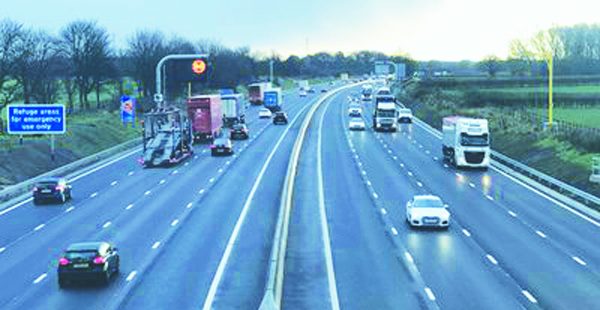A motorcyclist who blames a local smart motorway for the injuries he suffered in an accident has branded them a “death trap”.
The department for transport said this month that it was pausing the expansion of the new roads, where the hard shoulder was permanently a live traffic lane, until there was five years’ worth of data on drivers’ safety. Work was recently carried out on the M6 in Cheshire to make the Holmes Chapel stretch a smart road.
But Jack Gallowtree, who was seriously hurt in a crash on the local section of the M6, blasted the Government plan as “not going far enough” and called for them to be scrapped altogether.
Speaking to the Nottingham Post, the 34-year-old said he suffered a serious injury to his left leg after crashing on junction 18 at Holmes Chapel in April when his bike had a mechanical failure.
He said that rather than pausing the scheme, the Government should be looking to reintroduce the hard shoulder on the motorway.
He told the paper: “They say five years, but we’ve actually already had two of those five years so it’s only three years from now onwards.
“There’s always a catch and they’ve said it before – that they’d just suspend the ones that hadn’t been signed off on.
“But we’ve got a Government that seems to believe honesty is not the best policy. You see them squirm, bob and weave, using their wordplay all the time and it’s no different with smart motorways.
“If they remove the one consistent lifeline and element of safety (a hard shoulder) to replace it with half-a**** measures to try to make everything safer, they’re not going to turn around and say, ‘well yeah, it isn’t safer, we f***** up, caused however many people to die and however many to be injured’.
“They’re not going to put their hands up and acknowledge any wrongdoing or be held accountable. They’re going to do everything they can to avoid that. It’s just another disingenuous gesture.”
A recent Parliamentary report said the department for transport and Highways England had failed to deliver on promises to implement safety improvements for all-lane running smart motorways, saying safety risks should have been addressed before all-lane running smart motorways were rolled out and that data on safety of all-lane-running motorways was “limited and volatile”. The committee said communicating the “radical change” to motorway design had been “woeful”, with more than half of drivers still unclear on what to do if they broke down in a live lane.
The Government has promised to spend £900m to improve safety on the existing smart motorway network, including an extra £390m to install additional emergency areas.
Mr Gallowtree, of Wolverhampton, said it could be done for much less.
He said: “Paint is a hell of a lot cheaper than that. That’s all they need to do to reinstate the hard shoulder.”
He also called for the metal barriers to be removed, saying: “Those are lethal for motorcyclists anyway, but vehicles would be able to pull over onto the grass verge and out of the way.”
Smart motorways are sections of motorway in the UK that use new forms of technology and active traffic management techniques to increase road capacity.
Mr Gallowtree’s accident happened when he lost power in the outside lane and began working his way over to the inside lane where two lorries were travelling slightly behind him in what was previously the hard shoulder.
He moved over to the very outer edge of the tarmac in lane one, to give the lorries enough space to pass, when he said the bike bucked to the left.
As a result of the impact, Jack lost a piece of his left tibia, which lacerated his leg.
His kneecap was shattered by debris slicing through it, causing damage to the bones behind the patella.
The Government has undertaken a “stocktake and action plan”, which looked on further upgrading the safety of smart motorways. The Transport Committee’s report previously reported on all-lane running motorways in June 2016, concluding that the trade-off on safety was an “unacceptable price to pay” for the benefits of all-lane running.
The Transport Committee has called on the department for transport and National Highways to retrofit emergency refuge areas to existing all-lane running smart motorways to make them a maximum of one-mile apart, decreasing to every 0.75 miles where physically possible; insert the emergency corridor manoeuvre into the highway code to help emergency services and traffic patrol officers to access incidents when traffic is congested; commission the Office for Rail and Road to conduct an independent evaluation of the effectiveness and operation of stopped vehicle technology; and ask the Office of Rail and Road to evaluate the department’s progress, particularly the incidences and response times for live lane breakdowns and educating drivers on the correct action to take.
Chair of the Transport Committee Huw Merriman MP said: “Looking at the available evidence, smart motorways do appear to be safer than conventional motorways even once the hard-shoulder is removed.
“However, this evidence is also open to question. Only 29 miles of these all-lane running smart motorways have operated for over five years. It feels too soon, and uncertain, to use this as an evidence base to remove the hard shoulder from swathes of our motorway network.
“The same evidence shows that other forms of smart motorways, where the hard shoulder is converted to a live lane at peak times of congestion, have lower casualty rates than removing the hard shoulder altogether. Despite this, the Government intends to replace these with all-lane running schemes.
“Some 40% of breakdowns on all-lane-running motorways take place in live lanes. This is too high. With stopped vehicle technology in place, it takes National Highways an average of one minute to close the lane.
“In 2016, our committee was told that this safety technology would be introduced for all new smart motorways ‘going forward’ and retrofitted for existing stretches. The former chief executive of National Highways told us in 2019 that a number of lives would have been saved had the technology been in place sooner.
“To be told that this technology is being delivered 12 months early, by 2022, is an extraordinary claim given it is now five years late.
“We’re not convinced that reinstating the hard shoulder on existing schemes is the answer, but the DfT must pause the rollout and take stock.”





